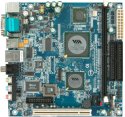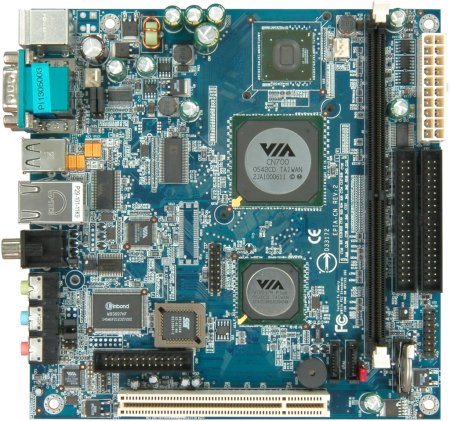Via aims low-power mini-ITX SBC at multimedia appliances
Jun 1, 2006 — by LinuxDevices Staff — from the LinuxDevices Archive — 5 views Via is shipping a power-efficient mini-ITX SBC (single-board computer) targeting digital media appliances. The Epia CN, based on a 1GHz-1.3GHz C7 processor and Via's newest desktop chipset, typically consumes 16 Watts, and features a simplified onboard peripheral and I/O set compared to previous C7-based mini-ITX boards. The CN allegedly runs Linux.
Via is shipping a power-efficient mini-ITX SBC (single-board computer) targeting digital media appliances. The Epia CN, based on a 1GHz-1.3GHz C7 processor and Via's newest desktop chipset, typically consumes 16 Watts, and features a simplified onboard peripheral and I/O set compared to previous C7-based mini-ITX boards. The CN allegedly runs Linux.
 |
(Click to enlarge) |
The power-efficient CN is Via's second mini-ITX board based on the C7, following the March debut of the performance-oriented Epia EN series (a prototype of which is pictured at right). Whereas Epia EN boards are six-layer PCBs (printed circuit boards) with slightly faster C7-based processors and a truly astounding array of I/O — in particular, I/O aimed at media processing applications — the new CN series boards feature a simpler four-layer design that still uses Via's newest desktop chipset. The CN boards eschew some of the more esoteric peripherals and I/O found in the EN boards, while still supporting advanced media features, such as an S-video port with “DuoView” dual-display capabilities (operation under Linux not confirmed).
The C7 processor that powers both the Epia EN and CN boards is built on 90nm SOI (silicon-on-insulator) process technology, and is being produced at an IBM fab in East Fishkill, New York. Via announced the C7 about a year ago, touting it as “the world's smallest, lowest power, and most secure native x86 processor.” The C7 processors are claimed to draw about half as much power, for the same performance, as Intel's Celeron M chips. Additionally, the C7 chips feature built-in cryptographic accelerators supported by Via's free security tools. Lots more details on the C7 can be found in our earlier story about the Epia EN boards.
Like the Epia EN, the Epia CN boards use a CN700 IGP chipset, which includes a CN700 northbridge and VT8237R Plus southbridge. The CN700 chipset features frontside (processor) and memory buses clocked at 533MHz, built-in Unichrome graphics, a rich variety of media interfaces (albeit some with binary-only Linux drivers), and a low-power design, Via says.
The four-layer Epia CN uses Via's newest desktop processor and chipset
(Click to enlarge)
The lower-powered Epia CN boards offer a fair number of onboard peripherals and I/O interfaces. However, compared to the earlier Epia EN, they lack Firewire/IEE1394 pin headers, and have only 10/100 Ethernet, instead of Gigabit Ethernet. Also missing are dedicated digital audio (S/PDIF) I/O ports, LVDS (low-voltage differential signal) connectors for LCD inverters/modules, component video I/O pin headers, SMBus connector, LPC connector, and SIR IrDA header (the CN does have CIR).
The Epia CN has an S-video port and supports dual-display
(Click to enlarge)
Epia CN specs listed by Via include:
- Processor (by model)
- Via Epia CN13000 — 1.3GHz VIA C7 (in nanoBGA2 package)
- Via Epia CN10000E — 1.0GHz VIA C7 (in nanoBGA2 package) Processor)
- Chipset
- Via CN700 northbridge
- Via VT8237R Plus southbridge
- Memory
- 1 x DDR2 400/533 DIMM socket
- Up to 1GB memory size
- VGA
- Integrated VIA UniChrome Pro AGP graphics with MPEG-2 decoding acceleration (binary only Linux support)
- Expansion and I/O
- 1 x PCI
- 2 x UltraDMA 133/100/66 connectors
- 2 x SATA II connectors, with RAID
- Via VT6103 10/100 LAN controller
- Via VT1618 8-channel AC'97 codec
- Via VT1625M HDTV encoder (TV out)
- PS/2 mouse and keyboard ports
- 1 x serial port
- 4 x USB 2.0
- 1 RCA port, switchable as S/PDIF or TV out
- S-video port
- Audio line-out, line-in, and mic-in ports, plus headers for front-panel audio
- 1 x USB header for 4 additional USB 2.0 ports
- 1 x CIR connector (switchable for KB/MS)
- 1 x LPT connector
- 1 x CD-in connector
- 2 x fan connectors — CPU, sys fan
- ATX power connector
- Award BIOS
- LPC 4/8 Mbit flash memory
- Supports Linux, Windows 2000/XP, Windows CE/XPe
- CPU temperature reading, CPU voltage monitoring
- Wake-on-LAN, keyboard-power-on, timer-power-on
- Watch dog timer, fan control
- System power management, AC power failure recovery
- Operating temperature — 0-50 degrees C
- Operating Humidity — 0 to 95 percent (relative humidity; non-condensing)
Daniel Wu, head of Via's embedded platform division, calls the new Epia CN board “a model embedded space workhorse that makes possible rapid development for a wide spectrum of applications.”
Availability
The Via Epia CN1300 appears to be available from stock, priced at about $225, from online retailers such as Logic Supply. The passively cooled Epia CN1000 does not yet appear to be stocked by online retailers, however.
This article was originally published on LinuxDevices.com and has been donated to the open source community by QuinStreet Inc. Please visit LinuxToday.com for up-to-date news and articles about Linux and open source.

